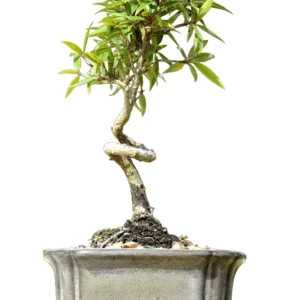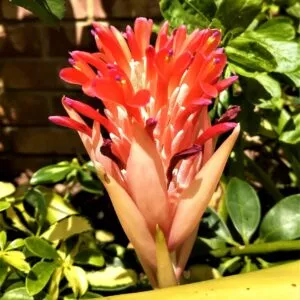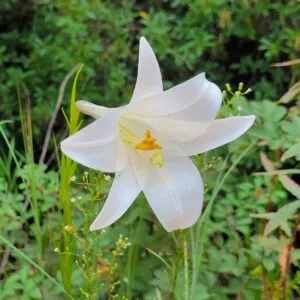No products in the cart.
Table of Contents
Isn’t this plant just unique? WOW? Look at those beautiful flowers. Now imagine growing calla lilies in your home.
To add to your indoor plant collection, you can grow calla lilies in different shades. You find them in pale pink, white, or dramatic colors from black to orange.
But before the indoor calla lily plants bloom, you must take care of them. So, today we will show you how planting calla lilies can brighten up your living space to create a splash of color.
What Are Calla Lilies?
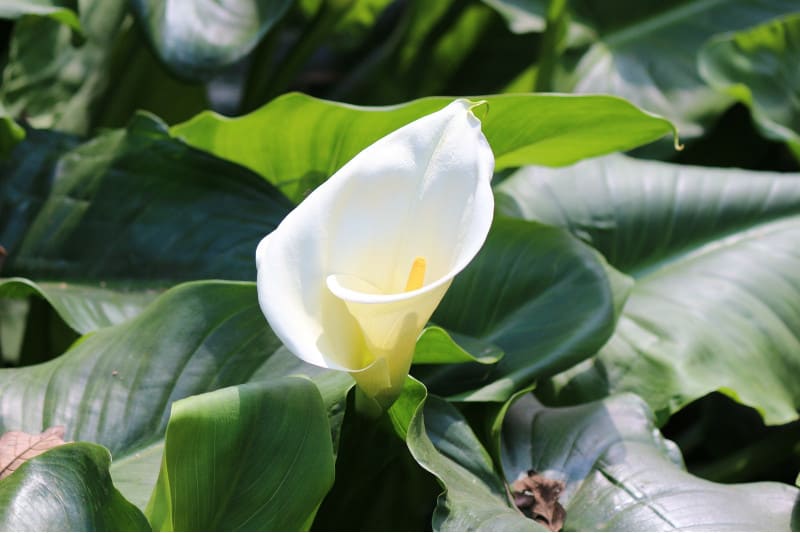
Many gardeners have a different name for the calla lily, the arum lily, a loved plant amongst gardeners for its fragrance and ornamental display. We cannot agree more, as Calla lilies blooming is fantastic.
But you see, the strange thing is that it is not a lily, but they share similar qualities. The flowers are used for wedding floral arrangements as well. The plant is graceful, exotic, and sensual, leaving countless gardeners surprised at how easy they are to care for and grow.
Another notable difference is that caring for white calla lilies differs from the colorful hybrid ones. The white bloom is semi-aquatic, as the calla lily rhizomes are always thirsty. In contrast, the colorful cousins prefer a higher ground as the tubers enjoy drainage.
Interestingly enough, this tropical plant comes from South Africa, and you find them growing along the rivers. The scientific name for Calla Lillies is Zantedeschia aethiopica.
Growing Calla Lilies

Great, now that you know some background history check out the short and sweet of taking care of your exotic plant here:

Recommended Potting Mix
Calla lilies grow well in moist, rich in organic loam in garden beds and containers with well-drained soil. Yet, as mentioned, your white arum lily prefers damp soil compared to hybrids.
The important thing is the ground needs to drain well, as you do not want it to become waterlogged, leading to root rot. Thus amend the soil with some organic matter to provide them with well-draining soil.
Lighting Needs When Growing Calla Lilies

One thing is sure this plant is true to its tropical nature and thrives in warmer environments with plenty of light. Still, if you live in humid weather, we recommend placing them in partial shade to full sun in a warmer climate.
But if the temperature summer climate is more then provide them with full sunlight. So it helps to check out the temperature and humidity to determine if your plant needs sun or partial shade.
Watering The Arum Lily
Calla lilies grow inside or outside the home. When grown indoors, your calla lily flowers need constant moisture. The reason is that pots dry out faster compared to planting them in the ground.
The important thing is to keep an eye on the soil and nourish it once you notice that the soil is slightly dry. But do not overwater or leave the ground soggy as it can make your plant sick.
Ideal Temperature & Humidity

Your calla lily loves a warm environment, sunbathing, and taking up the full sun. So it helps to provide your plant with temperatures between 60° to 80 °F. Another thing your plant will thank you for is humidity and moisture, so do not go and put your calla lily in a dark place.
But if the temperature drops below 50 °F, your plant goes into dormancy, and best to dig up the rhizomes outdoors for overwintering before it starts to freeze. You do not want your plant leaving you for plant heaven. Yet if your flower is indoors, you will not need to do this.
So the rule is to remember when it comes to Calla lily care, it is not winter hardy but can thrive in cooler climates without temperatures dropping below 50 °F. The best-growing tips for growing them outside in warm climates.
A Few Tips For Fertilizing
Usually, your calla lily needs no feeding. Yet, if you want them to grow better, you can use a liquid fertilizer without ammonium.
You can use one part of fertilizer mixed with a gallon of water once every two weeks for one season. You can do this at the beginning of the growing season as it helps to promote the calla lily flowers.
Still, prevent using too much nitrogen as it can reduce the flowering at bloom time.
In stock In stock In stock In stock (can be backordered)
Free Shipping
$72.60
Sold By:
BONSAI WORLD LLC
Coiled FICUS NERIOFOLIA Umbrella Bonsai Tree
Sold By:
BONSAI WORLD LLC
$8.00
Sold By:
Smoot's Farm
Succulent Echeveria Lilacina Ghost 4″ Pot Live Plant
Only 1 available and it’s in 1 people’s basket Rated 4.89 out of 5 based on 27 customer ratings00
Sold By:
Smoot's Farm
Free Shipping
$39.99
Sold By:
Aloha Hawaii Orchids
$44.99Dendrobium Bangkok Pink Orchid Comes in 4″ Pot
Rated 4.65 out of 5 based on 268 customer ratings00
Sold By:
Aloha Hawaii Orchids
Free Shipping
$21.99
Sold By:
Gar-Zen Botanical Design
Bromeliad Flaming Torch billbergia Ships Free
Only 6 available and it’s in 1 people’s basket Rated 4.86 out of 5 based on 49 customer ratings00
Sold By:
Gar-Zen Botanical Design
Propagating Arum Lillies
The fantastic thing is you can propagate your calla using rhizome or rooting division. You can also grow them from the bulbs. Then, when your lily starts to form clumps, you can divide them into individual plants.
Still, the best time to do this is when the growing season ends after flowering and the foliage turns yellow. So here are both methods described for you to generate more plants.
Calla Lily Rhizomes Division
Whether the foliage grows indoors or outdoors, you must pull the rhizome out of the ground.
Gather a clean pot with soil and circle the root when growing outside.
Pull the roots out, remove the dirt, and place them in a shady, well-ventilated area for a few days. Refrain from wetting them.
Once the rhizomes have dried out, take a sharp knife to separate them. Make sure it has at least one root growing from it.
Plant the rhizome in the new compost in a pot or a new garden bed with at least six inches of space between it and other plants. Keep the ground moist, or store the rhizomes over the winter.
Growing From Seeds
Okay, this method takes up to three years to bloom. First, you must pre-grow the seeds by spreading them on a damp paper towel. Then, place the seeds in a cool location and keep checking them after a couple of days of growth.
If any of the seeds show no sign of growth, discard them. Now place the seeds in a soilless medium, such as barely damp peat moss, or plant them in a pot with a thin layer of potting medium. Again, keep the ground moist and keep an eye out for growth. Finally, remove the weakest ones from each of the containers.
USDA Growth Zone

As a tropical plant, the calla lilies grow well in the USDA hardiness zones eight through ten. During summer, they will die back but do regrow every year. Still, in colder zones, you need to plant them as an annual.
But a note of forewarning from the California Invasive Plant Council is that the arum lily is a weed listed as an invasive species in California.
Potting and Pruning
Okay, the roots of your calla lily look a bit overcrowded and root-bound. Then it is time to repot your plant to thrive. You can invest in a pot three inches deeper and wider than the current one.
All you need to do is lift out the flowers and place them in the larger ones.
Now is also the right time to provide them with fresh soil and keep it moist for a few days. A great option is using a terracotta pot, allowing air and water to move freely through the walls. Still, it can dry out the soil fast, leaving you with frequent watering.
Yippee, your flower does not need regular pruning, but you can remove the wilted flower stems.
You can pinch it just below the base of the blooms using your fingertips. Still, if you live in a warmer zone, cut it down the ground at the end of the growing season.
When doing this, wear a pair of gloves to avoid the sap from getting on your skin.
Calla Lily Varieties
Your common calla lily has a yellow or white spadix and is the hardiest of most hybrids found. Still, there are other cultivars developed to add to your garden plant collection.
Zantedeschia ‘Edge of Night
You will love the black-to a dark purple color resembling a black velvet tint placed alongside your other calla lilies.
Zantedeschia ‘Red Alert’
Now, if red or orange is something you love, this plant is sure to surprise you with some spectacular blooms from May to August.
Zantedeschia ‘Picasso’
As the name implies, this bulb is sure a Picasso with its purple throat to bring color combinations to your white lily.
Zantedeschia ‘Sunshine’
Nothing will cheer up your living space or garden more than this plant with its bright yellow flower adding some sunshine to a dull home.
Calla Lily Plant Diseases & Pests
Cally lilies have been known to be disease-resistant. However, multiple factors can affect the plant’s nature that invite disease and pests. A notable problem is a bacterial soft root that affects calla lily bulbs.
Another problem is botrytis, a fungal infection causing a gray mold growing on the petals, leaves, and stems.
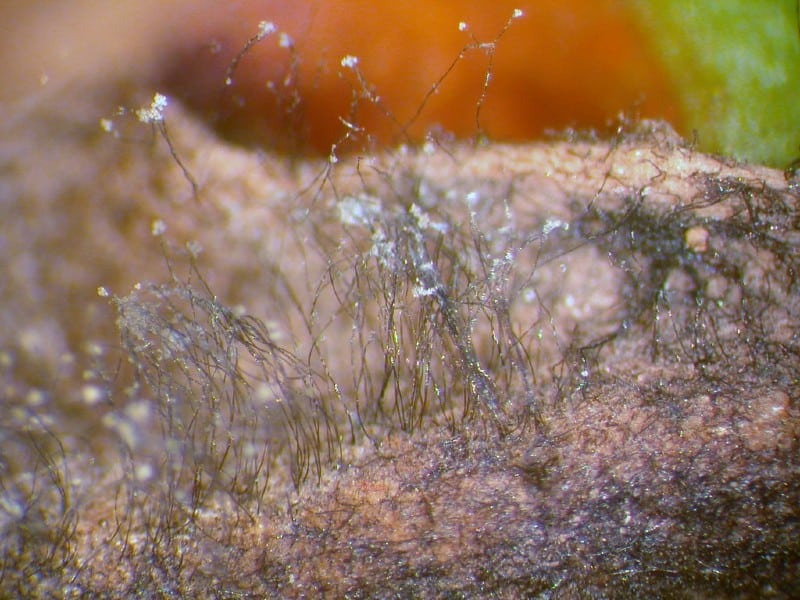
To prevent the risk, it helps not to overwater the potting soil. Also, when planted outdoors, it helps to make sure each flower is far apart with enough air circulation. Some pests that can cause issues are aphids, spider mites, and slugs.
To treat your plant, insecticidal soap or using horticultural oil such as neem oil helps.
Frequently Asked Questions
Once your plants stop flowering, refrain from watering them. Instead, please leave it to dry out as the foliage dies back, looking dead. Then you can remove the calla lily bulbs and place them in a dark place for the following planting season. But if you live in warmer climates, you can prune it to the ground and leave it to grow again in spring.
Your potted arum lily can live year after year when placed in a suitable climate. Yet, it will die two months a year, allowing it to rest and return with more blooms in the following growing season.
When placed in warmer climates, you can leave them in the ground or pot and cut them back to the ground. Yet, if you live in colder environments and treat them as outdoor plants, you must remove the bulbs from the earth to overwinter them. Doing this allows you to grow them as annuals.
Place new bulbs in the ground after the frost has passed and keep them spaced approximately 16 inches apart.
These plants spread with tuber fragments and seeds when planted directly into the ground.
These plants make for fantastic cut flowers and thrive in part shade in the garden in warm climates. You will enjoy the white flowers that bloom in late spring to early summer.
Whether you want to buy, sell, or simply reach out to other plant enthusiasts, Plantly is the right place to be!
In stock In stock In stock In stock
Free Shipping
$34.95
Sold By:
CKK PRODUCTS LLC
$39.95Dogwood white flowering seedling
Rated 5.00 out of 5 based on 1 customer rating00
Sold By:
CKK PRODUCTS LLC
$9.00
Sold By:
Cacti and Exotica
Alworthia pentagona
Rated 4.98 out of 5 based on 59 customer ratings00
Sold By:
Cacti and Exotica
$12.00
Sold By:
JLP farms TN
Nellie R Stevens Holly 2 1/2″ pot
Rated 4.85 out of 5 based on 602 customer ratings14
Sold By:
JLP farms TN
Free Shipping
$3.50 – $8.00
Sold By:
Chill Hill Farms
Philippine Lily | Lilium Philippinese | Florida Grown
Sold By:
Chill Hill Farms
